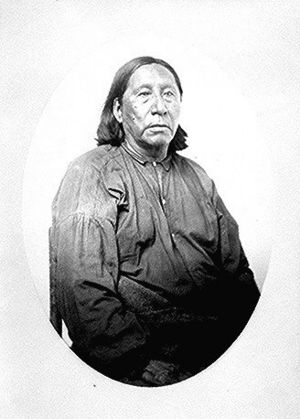Little Raven (Arapaho leader) facts for kids
Quick facts for kids
Little Raven
|
|
|---|---|
| Oh-has-tee, Hosa | |

Little Raven, some time between 1868 and 1874
|
|
| Southern Arapaho leader | |
| Personal details | |
| Born | c. 1810 Platte River, Nebraska |
| Died | 1889 Cantonment (present-day Blaine County, Oklahoma) |
| Children | Tato-Ka-Dan-Ska-Sun-Ka-Ku (son) others |
| Known for | negotiated peace between tribes, secured rights to Cheyenne-Arapaho Reservation |
Little Raven, also known as Hosa (which means Young Crow), was an important leader of the Southern Arapaho people. He was born around 1810 and became a main chief in 1855. He worked hard to bring peace between his tribe and other Native American groups like the Cheyenne, Comanche, Kiowa, and Plains Apache. Little Raven also helped his people get land rights for the Cheyenne and Arapaho Indian Reservation in what was then called Indian Territory. He was known for his calm leadership and powerful speeches.
Contents
Little Raven's Early Life and Leadership
Little Raven was born around 1810 on the central Great Plains. This area is now part of Nebraska, near the Platte River. He grew up to be a forward-thinking leader. People admired his dignified look and his amazing speaking skills.
In 1840, Little Raven played a key role in making peace. He helped the Southern Arapaho and Cheyenne tribes become friends with the Kiowa, Comanche, and Plains Apache. To help his tribe get food, he asked the United States government for farming tools in 1857. He also asked for lessons on how to farm.
Interactions with Settlers and Treaties
The Pike's Peak Gold Rush began in 1858. Thousands of white miners came to dig for gold on Native American lands. They built a large town called Denver. Little Raven and another chief, Chief Niwot, visited the new gold camp. They welcomed the white settlers and wanted to live peacefully with them.
Little Raven hoped the settlers would leave after finding their gold. But more and more settlers kept coming. While in Denver, Little Raven learned some new customs. He learned how to smoke cigars and eat with forks and knives. The Arapaho chiefs were so welcoming that the first county in the area was named after their tribe. Streets in Denver and Boulder were also named for them.
Signing the Fort Wise Treaty
On February 18, 1861, Little Raven signed the Fort Wise Treaty. Six Southern Cheyenne chiefs and three other Arapaho chiefs also signed it. However, Little Raven became upset when the white settlers did not follow the agreement. In 1863, he traveled to Washington, D.C..
During the summer of 1864, Little Raven kept his group of Arapaho south of the Platte River. He tried to avoid white soldiers and buffalo hunters. He stayed away from forts, trails, and settlements to keep his people safe.
After the Sand Creek Massacre
In 1864, Little Raven's disappointment turned to anger. This happened after the terrible Sand Creek massacre. Little Raven and his group survived because they were camped far away. Even so, Little Raven still sought peace. He signed the Little Arkansas Treaty on October 17, 1865.
When this treaty was broken less than 18 months later, he accepted the Medicine Lodge Treaty. He signed it on October 28, 1867, but only after the Cheyennes had signed it. This treaty gave the Southern Arapaho a reservation. It was located between the Arkansas and Cimarron rivers. This land is now in Oklahoma.
Later Life and Legacy
After the Battle of Washita River on November 27, 1868, Little Raven led his people to Fort Sill. They went there for protection. Later, the Southern Arapaho and Southern Cheyenne were given a reservation in western Indian Territory.
In 1871, Little Raven visited Washington, D.C. again. He also visited other cities in the East. He gave a speech to a large crowd at the Cooper Union for the Advancement of Science and Art in New York City. President Ulysses S. Grant offered him a peace medal. But Little Raven politely refused it. He said he had no peace to make because he had never been at war with white people. Little Raven encouraged the Southern Arapaho to stay neutral during the Red River War of 1874-75.
Little Raven eventually settled in Cantonment. This area is now in Blaine County, Oklahoma. The old military hospital there became his home. Little Raven passed away in Cantonment in 1889. His remains are buried at the Fort Sill Post Cemetery in Oklahoma.
Today, Little Raven Street in Riverfront Park in Denver honors his memory. It is located near the South Platte River.
Quotes from Little Raven
Little Raven was known for his powerful words. Here are some of his famous quotes:
I would like to shake hands with the white men, but I am afraid they do not want peace with us.
It will be a very hard thing to leave the country that God gave us. Our friends are buried there, and we hate to leave these grounds. ... There is something strong for us — that fool band of soldiers that cleared out our lodges and killed our women and children. This is hard on us. There at Sand Creek — White Antelope and many other chiefs lie there; our women and children lie there. Our lodges were destroyed there, and our horses were taken from us there, and I do not feel disposed to go right off to a new country and leave them.

